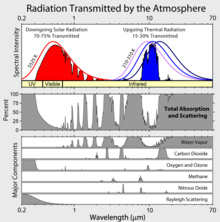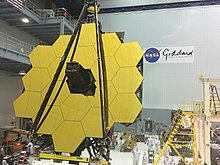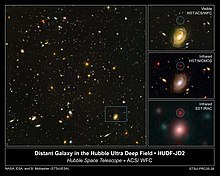List of largest infrared telescopes: Difference between revisions
m →Overall: SOFIA wavelengths from its article |
m →Overall: UKIRT wavelengths estimated from its article |
||
| Line 14: | Line 14: | ||
| [[VISTA (telescope)|VISTA]] || [[File:VISTA at Paranal Eso0704b.tif|70px]] || 4.1 m (161″) || 0.85 – 2.3 μm || [[Paranal Observatory|Paranal Obs.]], Chile || 2008 || <ref name="mess117">Emerson, J.P., Sutherland, W.J., McPherson, A.M., Craig, S.C., Dalton, G.B., Ward, A.K. (2005). [http://adsabs.harvard.edu/abs/2004Msngr.117...27E The Visible & Infrared Survey Telescope for Astronomy]. ''The Messenger''</ref> |
| [[VISTA (telescope)|VISTA]] || [[File:VISTA at Paranal Eso0704b.tif|70px]] || 4.1 m (161″) || 0.85 – 2.3 μm || [[Paranal Observatory|Paranal Obs.]], Chile || 2008 || <ref name="mess117">Emerson, J.P., Sutherland, W.J., McPherson, A.M., Craig, S.C., Dalton, G.B., Ward, A.K. (2005). [http://adsabs.harvard.edu/abs/2004Msngr.117...27E The Visible & Infrared Survey Telescope for Astronomy]. ''The Messenger''</ref> |
||
|- |
|- |
||
| [[United Kingdom Infrared Telescope|UKIRT]] || [[File:UKIRT at sunset.jpg|70px]] || 3.8 m (150″) || || [[Mauna Kea Observatories|Mauna Kea Obs.]], Hawaii || 1978 || |
| [[United Kingdom Infrared Telescope|UKIRT]] || [[File:UKIRT at sunset.jpg|70px]] || 3.8 m (150″) || 0.8 - 20 μm || [[Mauna Kea Observatories|Mauna Kea Obs.]], Hawaii || 1978 || |
||
|- |
|- |
||
||[[Herschel Space Observatory|Herschel Obs.]] || [[File:Herschel Space Observatory.jpg|70px]] || 3.5 m (138″) || 60-672 μm || Space, Sun-Earth [[lagrange point|L2]] || 2009-2013 || <ref name="Amos">{{cite news | title=ESA launches Herschel and Planck space telescopes | url=http://news.bbc.co.uk/2/hi/science/nature/8099105.stm | publisher=BBC | date= 14 June 2009| accessdate=10 November 2011 | first=Jonathan | last=Amos}}</ref> |
||[[Herschel Space Observatory|Herschel Obs.]] || [[File:Herschel Space Observatory.jpg|70px]] || 3.5 m (138″) || 60-672 μm || Space, Sun-Earth [[lagrange point|L2]] || 2009-2013 || <ref name="Amos">{{cite news | title=ESA launches Herschel and Planck space telescopes | url=http://news.bbc.co.uk/2/hi/science/nature/8099105.stm | publisher=BBC | date= 14 June 2009| accessdate=10 November 2011 | first=Jonathan | last=Amos}}</ref> |
||
Revision as of 19:33, 12 June 2021
This article needs additional citations for verification. (November 2011) |

List of largest infrared telescopes, by diameter of entrance aperture, oriented towards large observatories dedicated to infrared astronomy. Infrared has a number of challenges, especially for ground-based observatories but also in space. The near-infrared is similar to optical telescopes, although the longer wavelength infrared can also be related to aspects of radio and microwave astronomy. A major implication of looking at longer wavelengths are that infrared telescopes have a lower diffraction limit all else being compared to a visible light telescope, because the wavelength of light they are looking is longer. Secondly, infrared is heat, so the telescopes can be much more sensitive to emission of heat.
Overall
Infrared observations from Earth's surface are possible in a limited way but can be very dependent on location and atmospheric conditions. Water vapor blocks much of the infrared band in Earth's atmosphere, although some limited observations are possible and there is a number of infrared focused observatories, which often also view optical visible wavelengths. Sometimes other optical telescopes can make infrared observations if they are equipped with the right detectors, even if they are not dedicated infrared observatories. For ground-based observatories, the location can make a big difference in how much observation is possible.
| Name | Image | Effective aperture m (in) |
Wavelength Coverage |
Site | Year(s) | Refs |
|---|---|---|---|---|---|---|
| VISTA |  |
4.1 m (161″) | 0.85 – 2.3 μm | Paranal Obs., Chile | 2008 | [1] |
| UKIRT |  |
3.8 m (150″) | 0.8 - 20 μm | Mauna Kea Obs., Hawaii | 1978 | |
| Herschel Obs. |  |
3.5 m (138″) | 60-672 μm | Space, Sun-Earth L2 | 2009-2013 | [2] |
| IRTF | 3 m (118″) | Mauna Kea, Hawaii | 1979 | [3] | ||
| SOFIA | 2.5 m (98.4 in) | 0.3 - 655 μm | 747SP; Stratosphere | 2010 | [4][5] | |
| Hubble Space Telescope |  |
2.4 m (94.5 inches) | NIR only | Space, Earth orbit | 2009-2013 | |
| WIRO |  |
2.3 m (90.6 in) | Jelm mountain, 9656 ft. (2943m) | 1977 | [6] |
Space telescopes only


| Name | Effective aperture cm (in) |
Wavelength Coverage |
Year | Refs |
|---|---|---|---|---|
| JWST | 650 cm | 0.6-28.5 µm | 2021 (planned) | |
| Herschel Obs. | 350 cm (138″) | 60-672 μm | 2009 - 2013 | [2] |
| Hubble WFC3 | 240 cm | 0.2-1.7 μm | 2009 - | |
| Spitzer | 85 cm | 3-180 μm | 2003 - 2020 | [4] |
| Akari | 68.5 cm | 2-200 μm | 2006 -2011 | [4] |
| ISO | 60 cm | 2.5-240 μm | 1995-1998 | [4] |
| IRAS | 57 cm | 5-100 μm | 1983 | [4] |
| NEOSM | 50 cm | 4–5.2 & 6–10 µm | 2025 (planned) | [7] |
| WISE/NEOWISE | 40 cm | 3-25 μm | 2009-2011 & 2013 - | [4] |
| MSX | 33 cm | 4.3-21 μm | 1996 - 1997 | |
| Spacelab IRT | 15.2 cm | 1.7-118 μm | 1985 Aug | [8] |
| Human Eye † | ~1 cm | 0.39-0.75 μm | - |
† For comparison
See also
- Lists of telescopes
- Infrared telescope
- List of largest optical reflecting telescopes
- Space Flyer Unit
- Diffuse Infrared Background Experiment (all-sky infrared observation on COBE, launched 1989)
References
- ^ Emerson, J.P., Sutherland, W.J., McPherson, A.M., Craig, S.C., Dalton, G.B., Ward, A.K. (2005). The Visible & Infrared Survey Telescope for Astronomy. The Messenger
- ^ a b Amos, Jonathan (14 June 2009). "ESA launches Herschel and Planck space telescopes". BBC. Retrieved 10 November 2011.
- ^ IRTF homepage
- ^ a b c d e f JPL: Herschel Space Observatory: Related Missions
- ^ Krabbe, Alfred (March 2007). "SOFIA telescope". Proceedings of SPIE: Astronomical Telescopes and Instrumentation. Munich, Germany: SPIE — The International Society for Optical Engineering. pp. 276–281. arXiv:astro-ph/0004253. Bibcode:2000SPIE.4014..276K. doi:10.1117/12.389103.
- ^ University of Wyoming 2.3-meter Telescope (WIRO)
- ^ NASA to Build New Asteroid-Hunting Space Telescope 2019
- ^ Kent, et al. – Galactic structure from the Spacelab infrared telescope (1992).
